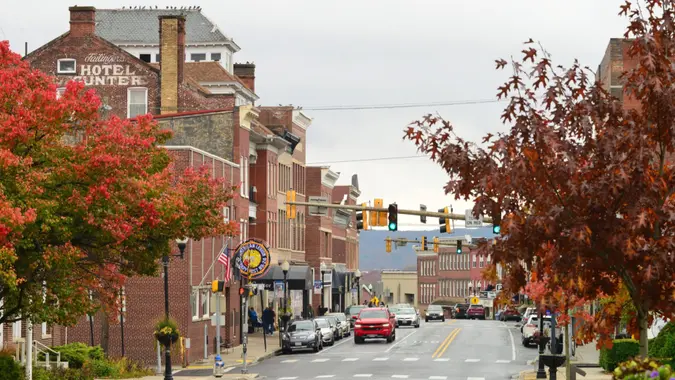If NYC’s 400,000 Millionaires Left Tomorrow, How Much Would Rent Drop?

Commitment to Our Readers
GOBankingRates' editorial team is committed to bringing you unbiased reviews and information. We use data-driven methodologies to evaluate financial products and services - our reviews and ratings are not influenced by advertisers. You can read more about our editorial guidelines and our products and services review methodology.

20 Years
Helping You Live Richer

Reviewed
by Experts

Trusted by
Millions of Readers
New York City has long been the glittering playground for the world’s wealthiest people. After all, if you can make it here, where luxury high-rises pierce the sky, designer boutiques line every avenue and exclusivity is the city’s currency, you can make it anywhere. With nearly 400,000 millionaires calling N.Y.C. home, the most of any city on the planet, its allure is undeniable.
But what if, overnight, these deep-pocketed residents decided to pack up and leave? How would the city’s famously sky-high rents respond? Would the departure of such a wealthy class finally open the door for the struggling middle class, or would the city’s housing crunch persist?
The Millionaire Influx and Middle-Class Squeeze
Over the past decade, N.Y.C. saw a 45% increase in millionaires, according to Henley & Partners data, now totaling nearly 400,000 — more than any other global city.
These affluent residents have increasingly overwhelmed the market for luxury rentals, exacerbating what experts call a “millionaire boom” that prices out the middle class. Meanwhile, median rents in Manhattan and Brooklyn have surged past $4,000 a month, putting immense pressure on middle-class households, many of which earn six figures.
What If Millionaires Left?
To estimate rent declines if millionaires departed, we can look to the COVID-19 era. When 305,000 residents left N.Y.C. between 2020-2021, as reported by Forbes, Manhattan rents dropped 16.6% and inventory increased sharply. A mass exit of 400,000 millionaires, who often reside in high-end properties, might resemble those conditions. If we assume they occupy a disproportionate share of luxury units, a similar population shock could again yield 10%-15% rent reductions or even more, primarily in upper-tier segments.
Market Mechanics and Realistic Projections
To understand how the departure of New York City’s millionaires might affect rent, it’s important to look at their outsized influence on the city’s housing market, particularly in the luxury segment.
- Millionaire renters are on the rise: Since 2019, N.Y.C. has seen a 157% jump in millionaire renters, according to RentCafe.
- An inventory glut would follow: If the nearly 400,000 millionaires exited the city, a wave of luxury units would hit the market, creating a surplus that could drive down rents.
- Downward pressure could ripple outward: As premium rents fall, some landlords may lower prices on mid-tier units to stay competitive, offering modest relief for middle-income renters.
- But supply constraints limit impact: New York’s chronic shortage of affordable housing and slow pace of new development mean citywide rent reductions would likely be limited and probably short-lived.
Broader Implications
Of course, even a hypothetical mass millionaire exit wouldn’t come without tradeoffs. A modest drop in rent could provide some long-awaited relief to the city’s squeezed middle class, but it wouldn’t fix the core issue: a severe shortage of affordable housing. Without a significant increase in supply, through new development, zoning reform or expanded tenant protections, any gains would likely be short-lived.
And then there’s the fiscal elephant in the room. N.Y.C.’s millionaires aren’t just tenants of luxury penthouses, they’re also a crucial part of the city’s tax base. By some estimates, the wealthiest residents contribute nearly half of the city’s income tax revenue. Their sudden absence could leave a multibillion-dollar budget hole, forcing cuts to essential services that working- and middle-class New Yorkers rely on. In short, yes, rent might drop, but at what cost?
Beyond the Price Drop
If New York City’s millionaires disappeared overnight, the most immediate impact would be felt in the luxury rental market. With thousands of high-end units suddenly vacated, rents in the top tier could drop 10%-15% or more as landlords rush to fill the vacancies. The ripple effect might reach the broader market, too, but more modestly. Citywide average rents might fall by 3%-5%, especially in areas where luxury units had inflated neighborhood prices overall.
However, any rent relief would likely be temporary. A sharp exodus of wealthy residents could trigger a short-term glut in inventory, but without new, affordable housing being built, demand would eventually rebound and prices would rise again. At the same time, fewer millionaires could leave a massive gap in N.Y.C.’s tax base, money that funds public schools, transportation and city services.
Long-term housing stability depends not on who stays or leaves, but on bold, structural changes: building more homes, protecting tenants and designing a city that works for everyone, not just the ultra-wealthy.
 Written by
Written by  Edited by
Edited by 

























